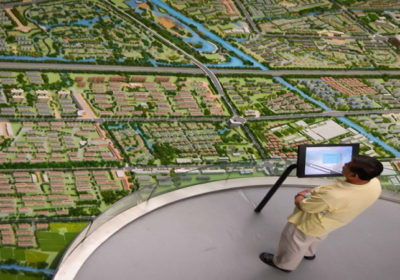
The transformation of a city into a Smart City can only happen through technology. It may be a basic concept, but many residents of cities that are already quite advanced may not be aware that it is the innovations that have emerged under the umbrella of Industry 4.0 that are being used to improve the efficiency, quality of life and sustainability of their places of residence. To achieve this, a smart city needs this technology to be organized in a solid and well-planned technical infrastructure, composed of some “basic” blocks that form the cogs that are to make the city’s “smart” services work.
Sensors and IoT devices that monitor operation and capture data
One of the key pieces of the technical infrastructure of a smart city is the network of sensors and Internet of Things (IoT) devices. These sensors are the ones that collect and transmit data on traffic, weather, energy consumption, water or the status of garbage containers, among other aspects of the city. The data collected is used to optimize the use of resources and improve efficiency in areas such as transportation, waste management and emergency management.
There are thousands of companies dedicated exclusively to the world of IoT sensors, as a Smart City needs them by the tens of thousands in areas such as:
- Temperature sensors: used to measure ambient temperature, often used in city climate measurement stations.
- Humidity sensors: Used to measure the relative humidity of the air.
- Motion sensors: Used to detect movement in a specific area and used to activate or deactivate systems when there is or is not movement around them.
- Light sensors: Used to measure light intensity, control street lighting on lampposts, etc.
- Pressure sensors: Used to measure pressure in a certain area.
- Gas sensors: : Used to measure the concentration of gases in the air and measure pollution.
- Proximity sensors: Used to detect the presence of nearby objects and alert the appropriate service or system, e.g., to automatically open an intelligent parking garage entrance door.
- Vibration sensors: Used to detect vibration in a certain area.
- Actuators: Used to control external devices, such as light bulbs, household appliances, etc.
- Tracking devices: Used to track the location of objects or people.
- Cameras: Used to capture images and videos in streets, avenues, areas with a lot of people and vehicles traffic, etc.
- Microcontrollers: Used to process and transmit data collected by sensors.
- Communication devices: Used to transmit the data from the sensors to a processing center or a cloud, since, if the data is collected, but not sent anywhere, it is of no use.
Then, these sensors must “talk” and “understand” each other to be able to send the collected data to the rest of the devices in the network, so they need certain communication protocols to do so. The most common standards used in IoT networks include:
- TCP/IP: This is the standard Internet communication protocol used to transmit data between devices.
- MQTT: It is a lightweight messaging protocol designed for connected devices with low processing power and limited bandwidth.
- CoAP: A protocol similar to HTTP designed for connected devices with low processing power and limited bandwidth.
- Zigbee: A low-power wireless protocol designed for home and home automation devices.
- Z-Wave: Another low-power wireless protocol, also designed for home and home automation devices. The difference is that Z-Wave networks allow up to 4 hops between devices, while Zigbee has no effective limit. Z-Wave networks are capable of supporting 232 devices, Zigbee networks up to 65000.
- Bluetooth Low Energy (BLE): It is a low power version of the Bluetooth protocol that is widely used in IoT devices.
- LoRaWAN: It is a long wavelength wireless communication protocol designed for IoT devices with low power and limited bandwidth.
The communications and data transmission network

Thanks to all of the above, as the city sensor system collects data on those elements that are being monitored (traffic, electricity consumption, street lighting, status of garbage containers, air quality, etc.) the next important part of the technical infrastructure of the Smart City is a robust communications network that allows the transmission of all this, because, as we mentioned before, if the data that is collected is not sent to be analyzed it is of no use.
Therefore, this network must be able to transmit all those packets of information at high speeds and with low latency to allow real-time communication between the different devices and systems of the Smart City, and must be able to connect to all devices and systems in the city, including sensors, cameras, IoT devices, transportation systems, among others.
Most smart cities use wireless technologies such as 5G, LoRaWAN, Zigbee or Sigfox for this purpose. The latter, Sigfox, is a low-power, low-data-rate wireless communication technology that is mainly used to connect IoT devices to a network. It is used for data transmission in applications such as asset monitoring, vehicle tracking, industrial telemetry, building automation, fleet management, etc. The technology is based on two-way communication through Sigfox’s own network, which is used to transmit information from devices to a data platform in the cloud.
Then, in any city, the communications network must have a scalable and secure architecture to be able to adapt to the changing needs of the city and guarantee the privacy and security of the data transmitted.
Regarding the use of next-generation mobile communications, some cities and operators have opted to test Open RAN (Open Access Network), which is an approach to the architecture of telecommunications networks based on the use of components from different manufacturers, instead of using equipment from a single supplier. The aim is to achieve greater flexibility and scalability and to improve market competition by lowering costs. Open RAN is mainly used to improve efficiency in the use of network resources, reduce ownership costs and facilitate innovation in communications systems, as well as to improve the security and accessibility of networks in remote or low-resource areas.
Finally, and in parallel, fiber optic and coaxial communications systems are used to connect buildings and data processing stations, and satellite communications technologies can be used to connect remote or hard-to-reach areas that cannot be reached by wireless or wired systems.
Systems for processing data collected from the city

The third major block forming the technological infrastructure of a Smart City is a large-scale data processing system, essential for converting the data collected into useful information. This usually includes the use of artificial intelligence and machine learning technologies to analyze the data and make automated decisions in real time, with increasingly powerful tools appearing in the field of AI for this purpose.
Grouped by fields of action, there are several data processing systems used in a Smart City, some of them being:
- Geographic Information Systems (GIS): used to collect, store, analyze and visualize georeferenced data, such as information on traffic, environment, public services, etc.
- Infrastructure information systems (IIS): Used to monitor and control urban services, such as water supply, street lighting, public transport, etc.
- Waste management information systems (WMS): Used to collect and analyze data on waste generation and management in the city.
- Citizen safety information systems (CSIS): Used to collect and analyze data on safety in the city, such as crime, fires, traffic accidents, etc.
- Mobility information systems (MIS): Used to collect and analyze data on traffic and mobility in the city, such as traffic patterns, public transport routes, etc.
Most of the data is processed and stored with cloud computing systems as a secure and scalable storage system is necessary to save and access the collected data over time. Therefore, in addition, it is also important to have a robust security system to protect them and avoid interruption of Smart City services.
Cloud computing systems work by providing a processing and storage infrastructure over the Internet. The data collected by sensors and IoT devices are transmitted over the network to a processing center in the cloud, to, once there, proceed to its analysis with big data tools. Generally, most cities use these tools to analyze patterns and trends in the collected data and to provide predictive analytics and automate decisions.
In addition, processing and storing city data in the cloud allows users and service managers to access it from anywhere and at any time, which facilitates real-time decision making. They also allow processing and storage to easily scale as needed to handle large amounts of data packets that are collected by sensors and IoT devices in an increasingly larger volumes in a smart city.
Security systems for Smart City structures and services
If the Smart City needs the previous blocks to be able to collect, transmit, process and analyze the operation of all its services, there is no point in creating all this infrastructure if security systems are not also installed in them. By security, we also mean cybersecurity, i.e. protection against hackers and attacks through the network. The installation of these systems in the Smart City structures is what protects data and tries to avoid the interruption of city services, and includes measures such as data encryption and device authentication, among many others.
The user interface

Finally, a smart city would not be useful to citizens if it does not provide them with the data and tools to take advantage of all the services that their city provides, hence an intuitive user interface is essential to allow city dwellers to interact with the technology and access the services it offers. In most cities, this includes multiple mobile applications, interactive panels along the streets and other means of communication that make it easier for all of the above to have a real and practical use for all city residents.
Why do we want to turn cities into Smart Cities?
Perhaps a part of the population can ask themselves the same question. The answer is that the main objective of turning a city into a “smart city” is to improve the quality of life of citizens, in an increasingly urban society where the population of cities grows and grows without stopping, so it is important to make the city more efficient, sustainable and competitive, including, broadly speaking:
- Improving efficiency in the use of resources such as water, energy and public services.
- Improving mobility through the use of intelligent transportation technologies, such as real-time traffic monitoring and planning more efficient public transport routes.
- Improve public safety through the use of smart surveillance cameras and object and people tracking systems to reduce crime, a particularly important issue in some cities around the world.
- Improve air quality and the environment through the use of pollution sensors and waste management systems.
- Improve the information available to citizens through the use of mobile applications to monitor urban services and public information systems, and to improve the accessibility and transparency of public services, municipal procedures, dealings with city councils, etc.
- Improve the city’s competitiveness through the use of smart technologies to attract investment and business, which in turn tends to improve the city’s image and reputation nationally and internationally.
There are many elements and building blocks that allow the transformation of a city into its smart counterpart to take place. In the end, it is technology at the service of society, and as such, finding the best way to apply it and put it into practice is what defines the quality of life we will be able to lead in our cities.



